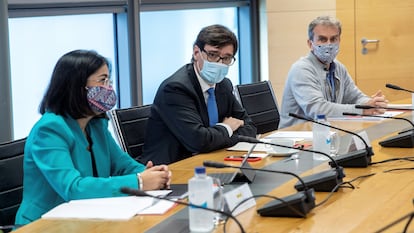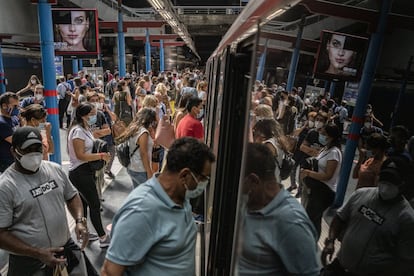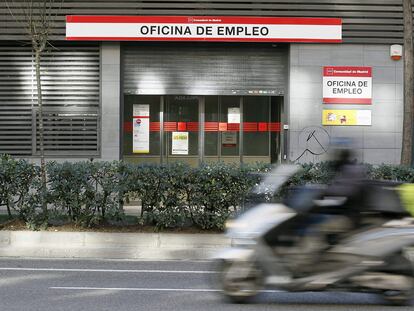As Madrid is offered 7,500 military personnel to combat coronavirus spread, experts consider what has gone wrong in the region
A complete lockdown may be inevitable, epidemiologists believe, with the measures currently in place being too little, too late

The rapid spread of the second wave of the coronavirus in Madrid prompted the Spanish government on Thursday to offer the regional administration 7,500 members of the military for assistance with contact tracing, disinfection and logistics. Also on the table for use by the Popular Party-run regional government are assistance from the Carlos III Health Institute and the Health Ministry’s Coordination Center for Health Alerts (CCAES). “Tough weeks are coming for Madrid, and as such we have to act with determination to take control of the pandemic in this region,” warned Health Minister Salvador Illa on Thursday, the day before the regional premier, Isabel Díaz Ayuso, is due to confirm whether current restriction in place that affect more than 850,000 Madrileños will be extended to other areas.
“The situation in Madrid is bad,” was the message that emerged from a meeting on Thursday between Illa, several other ministers, and key Socialist Party (PSOE) figures from the region. “A wider lockdown and new measures cannot be ruled out. Now we have to fight together, with loyalty and support for the Madrid government.”
With more than 100,000 new infections since August 1 in the Madrid region, the regional administration is once again staring into the abyss of a combined health, economic and social crisis
Since the first wave of the coronavirus in Spain, which took hold in March, there has been friction between the PP administration in the Madrid region – which is run in coalition with center-right Ciudadanos (Citizens) and propped up by far-right Vox – and the PSOE-run central government, which is also a coalition with leftist junior partner Unidas Podemos. During the state of alarm implemented by Prime Minister Pedro Sánchez, regional premier Isabel Díaz Ayuso regularly called for her government’s powers to be returned. In June, with the end of the state of alarm, this took place. Since the second wave of the coronavirus took hold, however, with Madrid once again becoming the epicenter of the epidemic, her government has been calling for the central administration to intervene.
With more than 100,000 new infections since August 1 in the Madrid region, and 3,215 coronavirus patients in its hospitals, the regional administration is once again staring into the abyss of a combined health, economic and social crisis. Since Monday, the residents of 37 basic healthcare areas – spread across six districts in the capital and another seven municipalities across the region – have seen their mobility limited to going to work, study or the doctors. Parks and gardens have been sealed off, while all establishments must close by 10pm.
Will this be sufficient to content the spread of the virus? The regional government, which opted for a “surgical” intervention rather than a new state of alarm, believes it will not. It is currently considering imposing restrictions in another seven municipalities, given that they now meet the requisite of having more than 1,000 infections per 100,000 inhabitants over the last 14 days.
According to experts, these measures have arrived too late, and many believe that the lockdown of the entire city will be inevitable in just a few days. Here are their views on the key issues for Madrid.
37 confined areas. Experts consulted for this article believe that the perimetric confinement of 37 zones has two problems. Firstly, that it should have been implemented earlier, when the incidence of the virus was not so high. Secondly, and related to the first point, contagion is now so widespread that “the incidence rate is extremely high in the whole city and region,” according to Ildefonso Hernández, the spokesperson for the Spanish Public Health Society (Sepsas). “There are few places with under 300 cases per 100,000 inhabitants,” he says. “That means that nearly the entire region needs extensive measures.” In addition, there are doubts about the effectiveness of a lockdown with so many exceptions. The restricted areas are low income and few people who live there can work from home, meaning that people are constantly coming and going, and often using public transport to do so.

Police checks. Even if these measures were considered to be effective, a selective lockdown requires police checks. It is clear that Madrid does not have enough officers to monitor that all journeys are justified. The regional government has requested the help of 222 police officers and civil guards for inspections and the levying of fines.
Closure of parks. None of the epidemiologists consulted can understand the decision to close parks in areas with high population density, while at the same time leaving open bars and restaurants – albeit with reduced capacity. Hernández admits that such open spaces can be areas where people interact, and as such there is a risk of infection. But he argues that they merely need to be monitored. “This is the open air and everything is visible,” he argues. “We can’t see inside betting houses,” he adds, in reference to another sector that has not been closed by the regional government. “Will officers be going inside to check [that the rules are being observed]?” he asks.
Public transportation. As well as the errors and bad decisions taken by the Madrid government, the experts also point to measures that are missing. Epidemiologist Jesús Molina Cabrillana was shocked to see images this week of the deputy premier of Madrid, Ignacio Aguado of Ciudadanos, inaugurating a hand-sanitizer dispenser in the Madrid Metro – six months after the state of alarm was first declared. “I want to see them increase the frequency of trains at rush hour in order to reduce the overcrowding and ensure safe distancing,” he says. “That is more important.”

Quarantines. The Madrid region is carrying out nearly 15,000 PCR tests every day, and currently has the worst positivity rate in Spain: 23% of tests are confirming a coronavirus infection, practically one in every four. The World Health Organization (WHO) has stated that this percentage needs to be below 5% to consider an epidemic to be under control. What’s more, with plans to carry out mass testing, the number of positives is going to rise. Will all of these people be able to quarantine according to the guidelines? Will their close contacts be able to self-isolate? The plan for the Madrid region so far does not include setting up dozens of medicalized hotels, as was done during the first wave, nor other installations that can function as a “Noah’s Ark” for the people who need a place to quarantine if they cannot do so in their home.
Mass-testing infrastructure. Díaz Ayuso announced this week that mass testing would begin for the more than 850,000 inhabitants of the 37 confined areas. But she did not explain how so many diagnoses would be carried out in just a few days, and the fact that her government requested “urgent military support” from the central administration on Wednesday suggests that there was no plan in place. As such, these tests will be delayed until next week. Defense Minister Margarita Robles on Thursday offered 7,500 members of the military to Madrid, but said that assistance had still not been formally requested. Medical staff from the region’s primary healthcare system have for weeks been calling for PCR tests to be carried out in tents or other mobile units, rather than in healthcare centers themselves. This is particularly necessary in the case of the locked down areas, where healthcare centers are already overwhelmed.
“They should be done in points that are independent from healthcare centers and by professionals that do not belong to primary healthcare staff,” says José María Molero, from the Madrid Family Medicine Society. “The results should be directly conveyed to citizens. If the result is negative, instructions should be given that no follow up is needed. For positive cases, the same system should recommend 10-day isolation and attention at primary healthcare in the case of symptoms or if the person needs time off work.”
English version by Simon Hunter.
Tu suscripción se está usando en otro dispositivo
¿Quieres añadir otro usuario a tu suscripción?
Si continúas leyendo en este dispositivo, no se podrá leer en el otro.
FlechaTu suscripción se está usando en otro dispositivo y solo puedes acceder a EL PAÍS desde un dispositivo a la vez.
Si quieres compartir tu cuenta, cambia tu suscripción a la modalidad Premium, así podrás añadir otro usuario. Cada uno accederá con su propia cuenta de email, lo que os permitirá personalizar vuestra experiencia en EL PAÍS.
¿Tienes una suscripción de empresa? Accede aquí para contratar más cuentas.
En el caso de no saber quién está usando tu cuenta, te recomendamos cambiar tu contraseña aquí.
Si decides continuar compartiendo tu cuenta, este mensaje se mostrará en tu dispositivo y en el de la otra persona que está usando tu cuenta de forma indefinida, afectando a tu experiencia de lectura. Puedes consultar aquí los términos y condiciones de la suscripción digital.
More information
Últimas noticias
Most viewed
- Sinaloa Cartel war is taking its toll on Los Chapitos
- Oona Chaplin: ‘I told James Cameron that I was living in a treehouse and starting a permaculture project with a friend’
- Reinhard Genzel, Nobel laureate in physics: ‘One-minute videos will never give you the truth’
- Why the price of coffee has skyrocketed: from Brazilian plantations to specialty coffee houses
- Silver prices are going crazy: This is what’s fueling the rally










































